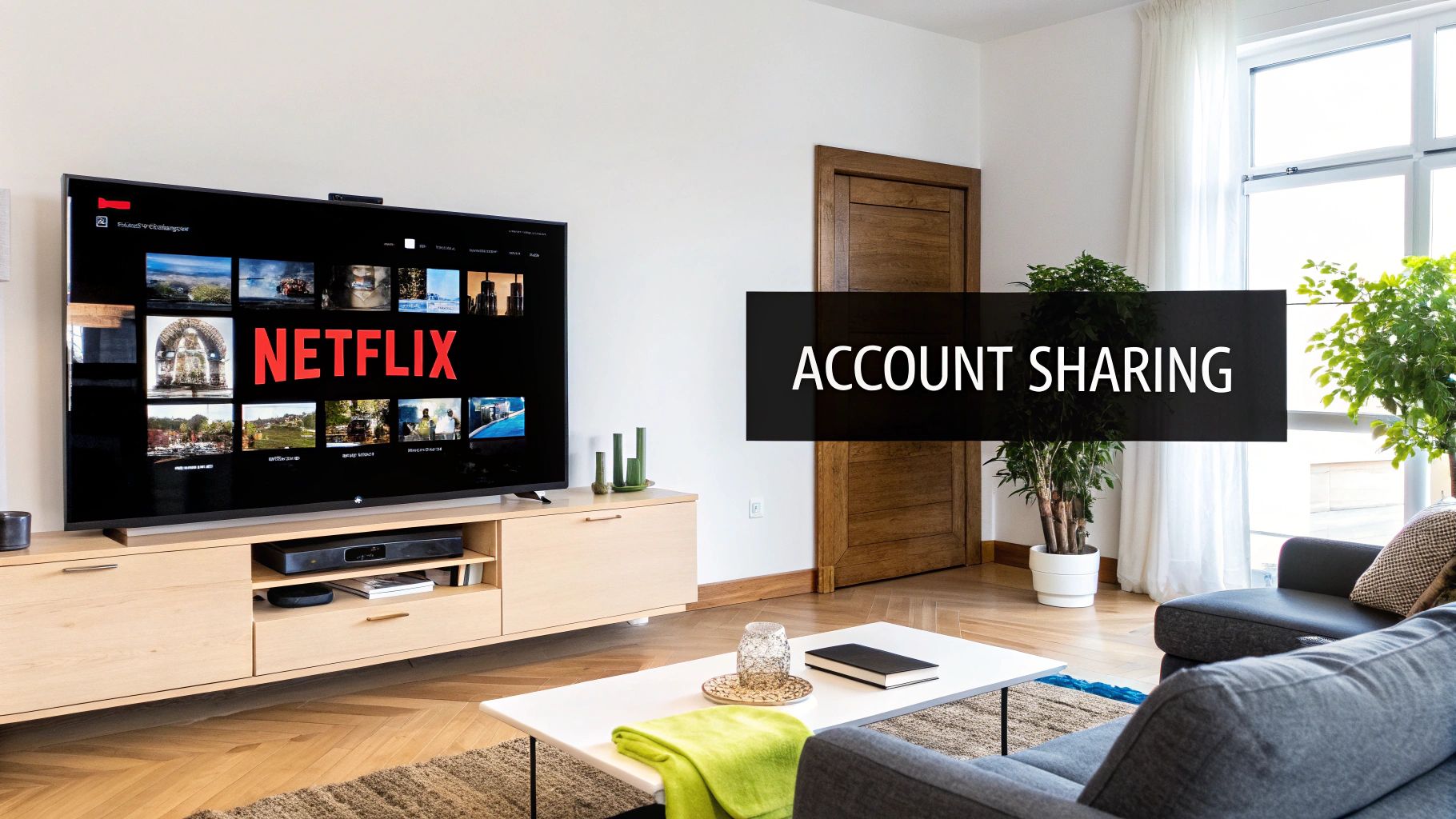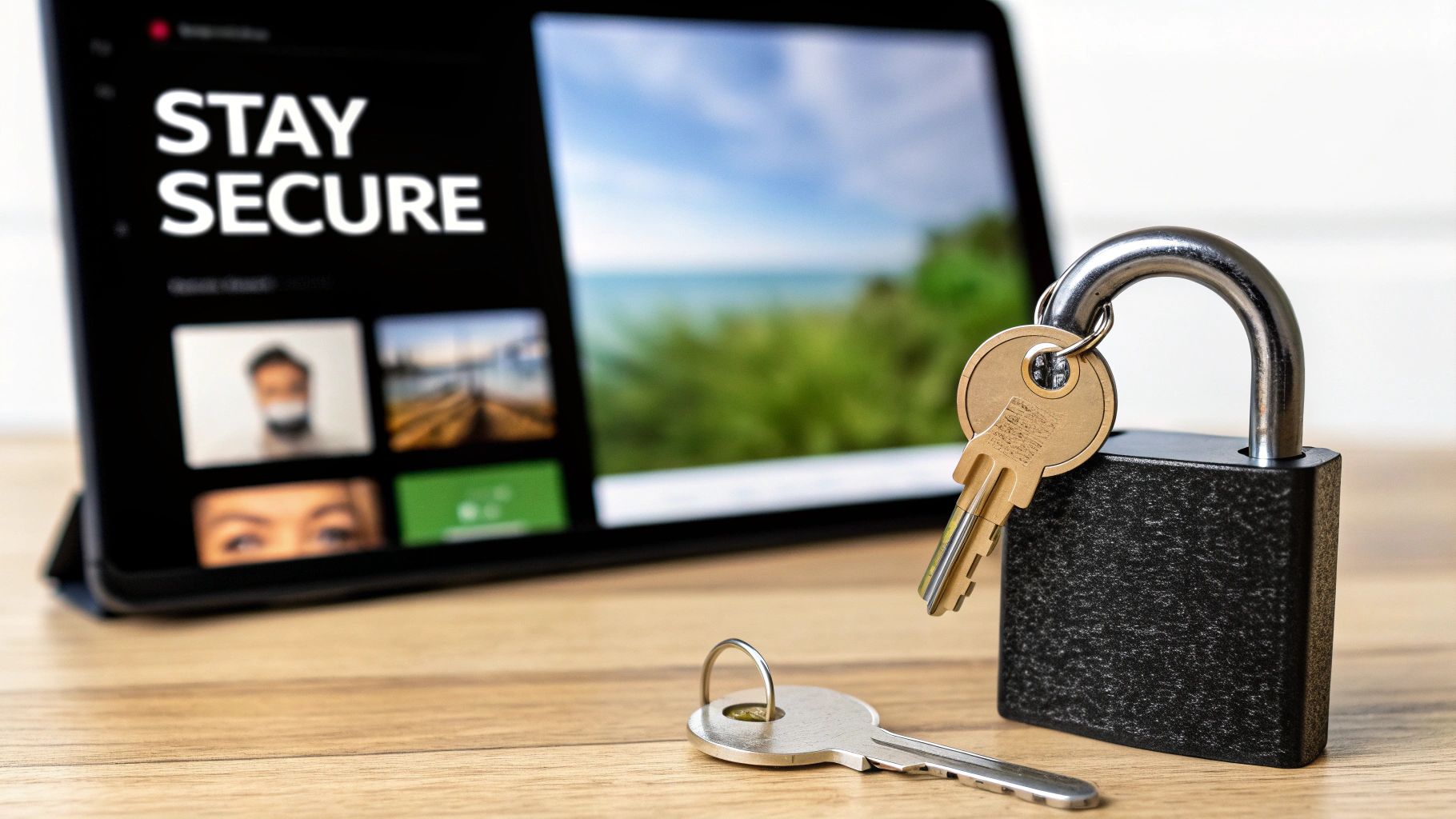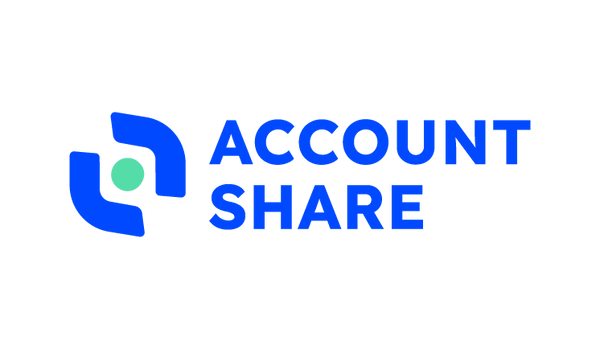
can netflix account be shared? Top Tips & Rules
Share
Netflix's Official Sharing Policies: What You Need To Know

Can a Netflix account be shared? The answer isn't a simple yes or no these days. Netflix initially had a more relaxed stance on sharing, but those policies have changed. Understanding these changes is important for avoiding account restrictions and getting the most out of your subscription. This section clarifies Netflix's current position on sharing, explaining what's allowed and what's not.
Understanding "Household" Sharing
Netflix's terms of service now state that accounts are meant for people living in a single household. Sharing within your home is generally okay. Sharing with friends or family who live elsewhere, however, is where things get tricky. This policy shift reflects Netflix’s goal of balancing user experience with generating revenue. They want to allow legitimate sharing but also limit unauthorized access, which impacts their profits.
For example, sharing with a roommate or family member in your home is usually fine under the "household" rule. Giving your password to a friend across the country, though, would violate these terms. This raises the question of how Netflix defines a "household."
How Netflix Defines (and Enforces) a Household
Netflix uses several methods to figure out if sharing is happening within a single household. They mainly look at primary location settings, which identify the main Wi-Fi network connected to the account. They also monitor device usage patterns, checking for logins from multiple locations and unusual viewing activity. This information helps them tell the difference between normal household use and broader, unauthorized sharing.
Netflix has acknowledged that account sharing is common, stating that over 100 million households share accounts globally. This affects their ability to invest in new content. Consequently, they've introduced new policies and features since early 2023.
To address this, the following table summarizes Netflix's current subscription options and their sharing capabilities:
Netflix Subscription Plans and Sharing Capabilities This table outlines the different Netflix subscription tiers and their official capabilities for simultaneous streams and profile creation, helping readers understand what level of sharing is built into each plan type.
| Plan Type | Monthly Cost | Simultaneous Streams | Max Profiles | Extra Member Add-on Available |
|---|---|---|---|---|
| Basic | $9.99 | 1 | 1 | No |
| Standard | $15.49 | 2 | 2 | Yes |
| Premium | $19.99 | 4 | 4 | Yes |
Note: Pricing and availability of features may vary by region. This table represents general US pricing as of October 26, 2023.
As you can see, the more expensive plans offer more simultaneous streams and profile options, reflecting Netflix's intent to allow for more sharing within a household. The addition of the "Extra Member" feature allows users to legitimately share with individuals outside their home for a small fee.
In some areas, Standard and Premium subscribers can add extra sub-accounts for a monthly fee, offering separate logins and profiles for people outside their household. This might be CAD$7.99 in Canada or €3.99 in Portugal. Netflix continues to roll out tools like primary location settings and device management worldwide to improve user control and address unauthorized sharing. You can learn more here. These changes demonstrate Netflix's attempts to monetize current sharing practices while controlling account access.
These efforts demonstrate how complicated sharing has become. While some sharing is still okay, understanding the specific rules and regional variations is vital for avoiding problems. Knowing what triggers Netflix’s enforcement can help you manage your account effectively.
The Evolution of Netflix Sharing: From Encouraged to Restricted

In its early days, Netflix actively encouraged account sharing. This strategy proved crucial for rapid growth and establishing market dominance. In 2016, co-founder and CEO Reed Hastings even stated that password sharing was "something we have to live with." This lenient approach normalized sharing and helped build a massive user base.
However, this laissez-faire attitude eventually shifted. As the streaming market became more competitive, Netflix began viewing widespread sharing as a lost revenue opportunity. Several factors drove this change, including rising production costs, the arrival of competing streaming services like Disney+, and pressure from investors.
The Turning Point: Why Netflix Changed Its Stance
Historically, Netflix password sharing was widespread yet stable. A 2021 study revealed that 11% of U.S. Netflix users shared their logins, a consistent figure over three years. This was on par with Disney+ for the highest percentage of shared logins. The study also showed higher sharing rates among single adult and multi-adult households without children. These patterns highlight how social and household structures influence sharing behaviors.
Furthermore, Netflix's tiered subscription model – one stream on Basic, two on Standard, and four on Premium – aimed to balance household flexibility and revenue protection. You can learn more about these password sharing trends here. This balancing act is a challenge for all streaming providers.
Netflix's transition away from encouraging sharing wasn’t abrupt. Initially, tiered subscription plans with varying simultaneous streams were introduced. This subtly discouraged broader sharing while accommodating families. This strategy paved the way for more direct restrictions.
Implementing Restrictions: How Netflix Controls Sharing
Netflix then began implementing technical measures. These focused on identifying and restricting unauthorized account sharing. By monitoring IP addresses, device IDs, and viewing habits, the company could detect logins from multiple, geographically dispersed locations. This technological approach marked a significant departure from their earlier tolerance. Netflix also began actively communicating updated policies to users, emphasizing single-household accounts.
This evolution in Netflix’s approach – from encouragement to restriction – reflects the company’s adaptation to the changing market. It also highlights the complex relationship between streaming services and their users, as companies strive to balance accessibility and revenue generation. Understanding this evolution is crucial for navigating today's world of Netflix sharing.
Inside Netflix's Password Sharing Crackdown: What's Changed

Netflix's shift from a laissez-faire attitude towards password sharing to actively restricting it has left many wondering: what happens when your account gets flagged, and how are subscribers reacting? This isn't about the occasional long-distance login anymore. Netflix now uses a variety of methods to track account activity and identify potential breaches of its terms of service.
How Netflix Detects Sharing
Netflix employs several techniques to identify improper password sharing. IP address tracking monitors the locations an account is accessed from. Consistent logins from geographically distant areas can raise a red flag. Device fingerprinting, another method, identifies the specific devices used to stream. A sudden surge in the number of devices linked to a single account, especially across different locations, can trigger scrutiny.
Netflix also analyzes location verification patterns. This involves monitoring the primary location registered by the account holder and comparing it to login locations. For example, if your primary location is set in New York, but your account is regularly accessed from California and Texas, Netflix might suspect sharing beyond your household. These methods, while sophisticated, are designed to distinguish between typical household use (family members streaming on different devices within the same home) and sharing across separate households.
The Consequences of Flagged Accounts
Several things can occur if Netflix suspects unauthorized sharing. You might receive an email warning, urging you to verify your account or modify your sharing habits. In some situations, Netflix might restrict access until the primary location is validated. This typically involves clicking a verification link sent to the account holder's email.
More serious consequences include account suspension or even termination, though these are usually reserved for persistent offenders.
Subscriber Responses and Netflix's Effectiveness
Subscriber reactions to the crackdown have been varied. Some users, acknowledging they were violating the terms of service, have complied by creating their own accounts or using legitimate sharing features like "Extra Member." Others have explored workarounds, such as using VPNs to mask their location or regularly updating their primary location.
A 2024 US survey revealed that over one-third of Netflix subscribers shared their passwords with 1-2 people. Interestingly, over 60% reported no change in their habits, claiming they shared only within their household. Another 15% chose a family plan to legally include external users. More detailed statistics can be found here. This data reveals a combination of adherence to existing household sharing and a willingness to pay for expanded access.
The effectiveness of Netflix's strategy remains a subject of debate. While features like "Extra Member" have generated new revenue streams, the crackdown has also contributed to some subscriber churn, especially among those unwilling or unable to pay the premium for shared access. The long-term implications of these changes on Netflix's subscriber base and profitability are yet to be determined.
Smart Ways To Share Your Netflix Account Without Breaking Rules

While the era of freely sharing Netflix passwords is fading, there are still legitimate ways to share your account. It's all about understanding the options Netflix offers and using them wisely.
Introducing Netflix's "Extra Member" Feature
The Extra Member feature is Netflix's official answer to out-of-household sharing. It lets Standard and Premium plan subscribers add extra members, each with their own profile, login, and personalized recommendations. This solves the problem of wanting to share with family or friends living elsewhere while staying within Netflix's terms of service. It also helps Netflix generate revenue from a practice that has long posed a challenge.
For instance, grandparents can share their account with grandchildren in another city, or friends can share the cost of a Premium plan by adding extra members. This is a more structured and legitimate method than simply handing over your password.
Setting Up and Managing Extra Members
Adding an Extra Member is typically simple. Go to the "Account" section in your Netflix account settings and find the "Extra Member" option. From there, you can invite people via email. Each extra member will have a unique login, eliminating the need for them to use your main account credentials. This separation enhances security and control over your account.
The main account holder manages the Extra Members. This includes paying the extra member fees and having the ability to remove members as needed. This system provides clear accountability and simplifies management of shared accounts.
Regional Variations and Pricing
The cost and availability of Extra Members vary by region, reflecting differences in local market conditions and standard subscription costs. The extra member fee might represent a large portion of the basic plan cost in some countries but only a small addition in others.
The table below, "Netflix Extra Member Pricing by Region," summarizes these variations. It offers a clear comparison of costs associated with adding extra members to your Netflix account in different areas, highlighting the financial aspects of legitimate account sharing.
| Region/Country | Extra Member Monthly Fee | Compared to Basic Plan (%) | Limitations |
|---|---|---|---|
| Canada | CAD$7.99 | ~80% | Limited to one extra member on Standard plan, two on Premium |
| Portugal | €3.99 | ~40% | Similar limitations to Canada |
| Spain | €5.99 | ~60% | Similar limitations to Canada |
| US | $7.99 | ~80% | Similar limitations to Canada |
As you can see, the cost of sharing with Extra Members can vary significantly. Understanding these regional differences is essential for assessing the value of this feature. Keep in mind that the number of extra members you can add often depends on your subscription tier.
Maximizing Your Netflix Sharing Experience
Proper use of the Extra Member feature helps avoid triggering Netflix's sharing detection algorithms. Setting your primary location accurately is vital to prevent unwanted service interruptions. Frequent travelers should regularly connect to their home network to confirm their primary location.
Using individual profiles on the shared account is also crucial. This ensures personalized recommendations for each viewer, making the experience more tailored to their preferences. Should an extra member opt for their own subscription, their profile data can be transferred, preserving their viewing history and preferences. Following these guidelines allows you to enjoy your Netflix subscription fully, share it legitimately, and ensure a smooth viewing experience for everyone.
How Netflix Knows You're Sharing: Tech Behind The Scenes
Netflix's approach to detecting account sharing isn't as simple as checking IP addresses. It's a sophisticated system designed to identify suspicious activity while still allowing for legitimate uses. This section explains the technology Netflix uses, revealing what they monitor and how they differentiate between acceptable and unacceptable sharing.
Key Signals Netflix Monitors
Netflix uses a combination of factors to determine if an account is being shared outside a single household. One primary method is IP address monitoring. Your IP address identifies your internet connection’s location. If an account consistently logs in from different, geographically distant IP addresses, it suggests possible sharing beyond the household. For example, regular logins from New York and California for an account with a primary location set in Texas could trigger a warning.
Device identification also plays a key role. Netflix tracks the devices used to access an account. A large number of different devices, especially when used from various locations, can be a red flag. Imagine ten different phones and smart TVs accessing the same account from various cities—this would certainly raise suspicion.
Netflix also examines viewing patterns. Unusual activity, such as multiple streams occurring simultaneously across dispersed locations, or drastically different content being watched back-to-back, might raise alerts. This is especially true if these viewing patterns deviate significantly from the established habits associated with a specific account.
Algorithms and Differentiating Between Shared and Household Accounts
Netflix’s detection system isn’t just about collecting data; it’s about analyzing it. Algorithms process this data to identify suspicious activity. The algorithms are designed to understand legitimate use cases, like family members using the account on different devices within the same home, or a subscriber traveling and accessing Netflix from a hotel.
These algorithms look for patterns. Consistent logins from a small set of devices within a limited geographical area suggest a single household. Sporadic logins from a constantly changing array of devices spread across the country, however, are more likely to signal unauthorized sharing. This pattern-based approach helps Netflix differentiate between sharing within a household and broader, unauthorized sharing.
Handling Edge Cases: Travelers and Students
Netflix understands that people travel and that students might live away from home. Their system considers these situations. While occasional logins from different locations won’t necessarily trigger alerts, it’s recommended that frequent travelers periodically connect to their home Wi-Fi network. This helps confirm the primary location and prevents Netflix from flagging the account.
For college students using their family's Netflix account, maintaining an active connection to the home network during breaks or holidays reinforces the connection to the primary household. This minimizes the chances of the account being flagged due to logins from a distant college location. This demonstrates Netflix’s attempt to address real-world scenarios while still enforcing its sharing policies.
Avoiding False Positives
To avoid being mistakenly flagged for sharing, ensure your primary location setting is accurate and up-to-date. If you move, update this setting immediately. Connect to your home Wi-Fi network regularly, especially if you travel frequently. This maintains a clear link between your account and your primary residence.
By understanding how Netflix detects sharing and taking proactive steps to maintain your account’s connection to your primary location, you can enjoy your subscription without disruption and ensure you're using your account within Netflix’s terms of service.
Is Sharing Netflix Still Worth It? The Real Cost Analysis
With Netflix's new sharing restrictions and fees, many are reevaluating the value of shared accounts. This analysis helps you decide if sharing still makes financial sense. We'll compare the costs of individual versus shared accounts, factoring in extra member fees across different scenarios. We'll also look at non-monetary factors impacting your decision.
The Financial Breakdown: Shared vs. Individual Accounts
Let's crunch the numbers. The core question is: when does sharing become more expensive than individual subscriptions? The answer depends on several factors, including the number of sharers and the extra member fees.
- Single Extra Member: Sharing with just one person outside your household? The "Extra Member" feature is usually the most cost-effective. Adding an extra member is generally cheaper than two separate Netflix Basic plans.
- Multiple Extra Members: As the number of sharers increases, the math changes. With two or more extra members, the cost can rival or even surpass multiple individual accounts. Separate subscriptions may then become more attractive.
The table below compares costs based on the Standard Netflix plan (two simultaneous streams). We'll assume adding an extra member costs $7.99.
| Number of Sharers | Standard Plan with Extra Members | Individual Basic Plans |
|---|---|---|
| 2 | $15.49 + $7.99 = $23.48 | $9.99 x 2 = $19.98 |
| 3 | $15.49 + (2 x $7.99) = $31.47 | $9.99 x 3 = $29.97 |
| 4 | $15.49 + (3 x $7.99) = $39.46 | $9.99 x 4 = $39.96 |
This example clearly illustrates how adding multiple extra members quickly inflates the cost. With four sharers, separate Basic subscriptions become slightly more economical.
Hidden Costs of Sharing
Beyond subscription fees, consider these less obvious costs:
- Loss of Control: Sharing login details means less control over your viewing history, recommendations, and account settings.
- Recommendation Algorithm Interference: Sharing impacts personalized recommendations, as Netflix attempts to cater to multiple viewers' tastes.
- Potential for Disputes: Shared arrangements can cause disagreements about payments, viewing choices, or account access.
These hidden costs can diminish your Netflix experience.
When Sharing Remains Advantageous
Despite the new rules, sharing can still be a good option:
- Occasional Sharing Within a Household: Sharing within your home is still permitted and encouraged, particularly for families using multiple profiles.
- Infrequent External Sharing: Sharing with occasional users might be cheaper than a separate subscription, provided it complies with Netflix's terms.
Non-Monetary Factors to Consider
Cost isn't everything. Consider these additional factors:
- Convenience: Managing shared accounts, especially with extra members, involves coordination and payment tracking. Separate accounts offer more autonomy.
- Privacy: Sharing sacrifices some privacy regarding viewing habits and account access. Individual accounts provide better confidentiality.
- Personalization: Separate accounts guarantee personalized recommendations, enhancing your viewing experience. Shared accounts can compromise personalization.
Making the Right Choice for You
Ultimately, the value of sharing depends on your individual needs. Weigh the financial factors, potential drawbacks, and personal preferences. A thorough analysis will help you determine the optimal approach.
Want a smarter way to manage shared accounts? AccountShare offers a platform for group purchasing and account management, ensuring value while maintaining control. Check out AccountShare at https://accountshare.ai and explore a new way to share premium services.
